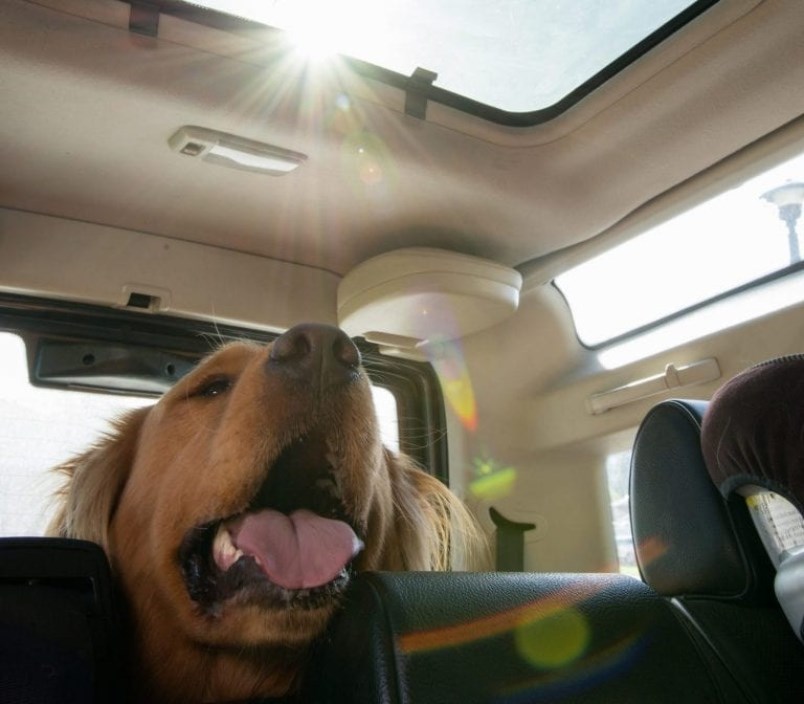Burnaby RCMP are warning the public that it’s warmer than people think when it comes to pets, especially dogs in vehicles.
The local police Twitter account tweeted about getting a call on the weekend about a dog left in a hot car as temperatures surged over recent days.
“Thankfully, it was not distressed,” say police.
Yes, thankfully, but thanks for nothing to the driver who left their dog to sit in a hot vehicle.
Spring is here and as we’ve seen, it’s getting pretty hot so if you are going out to run errands, don’t take your dog with you. That way you won’t be silly enough to put them at risk.
Here are some tips and information from the BC SPCA.
How long is too long in a hot or warm car?
Owners and caretakers may believe they’re doing their furry friend a favour when bringing them along on errands, but if they can’t bring their pet into a store they may think a few minutes in the vehicle won’t be a big deal.
For a dog, though, harmful, and even life-threatening effects can occur in a short time in a hot car. Dogs can’t release heat by sweating, as humans do, so their internal body temperature rises more quickly.
Some dogs, including senior pets and those with flatter faces, experience even more challenges in hot weather. At the end of the day, it’s best to simply leave your dog at home where there’s more space, water and shade.
What you should do
If you see an animal in distress in a parked vehicle, here’s the steps to take:
- Note the license plate, vehicle colour, make and model and ask managers of nearby businesses to page the owner to return to their vehicle immediately. If the animal is not showing signs of distress, but you are concerned, you may wish to stay by the vehicle to monitor the situation until the owner returns.
- If the animal is showing clear signs of heatstroke or other distress symptoms, call your local animal control agency, police, RCMP or the BC SPCA Call Centre at 1-855-622-7722 as soon as possible. The BC SPCA has a limited number of constables – if one is not available in the area the Call Centre can advise you about other emergency numbers to call so that help will arrive as quickly as possible.
What not to do
Break the window
While most people mean well when they say they’d be willing to break a glass window to get an animal out of a roasting vehicle, it’s strongly recommended you don’t.
- Only RCMP, local police, and BC SPCA Special Constables have the authority to enter a vehicle lawfully to help a pet in distress.
- Not only are you putting yourself at risk when you break a glass window, but you also risk harming the dog.
Leave the A/C on
You may have seen the sign on a vehicle saying, “the A/C is on.” Some may think this is an option, but it is not a good one. Your pet can still end up at risk if the air conditioning stops working, it’s not a guaranteed solution. It’s best to simply leave your dog at home where there’s more space, water and shade.
Dealing with pet heatstroke
Signs of heatstroke include:
- Exaggerated panting (or the sudden stopping of panting);
- Rapid or erratic pulse;
- Salivation, anxious or staring expression;
- Weakness and muscle tremors or lack of coordination;
- Convulsions or vomiting, and collapse.
If the animal is showing signs of heatstroke and you’re able to safely and lawfully move the animal out of the vehicle, do the following:
- Move the animal to a cool, shady place;
- Wet the animal with cool water.
- Do not apply ice as this will constrict blood flow and discourage cooling;
- Fan the animal to promote evaporation.
- This cools the blood, helping to reduce the animal’s core temperature;
- Allow the animal to drink some cool water (or to lick ice cream if no water is available);
- Take the dog to a veterinarian as soon as possible for further treatment.
How you can help
Carry a kit
- Keep a kit in your car in case you spot an animal in distress.
- This includes bottled water, a small bowl, a small battery-powered fan, and a towel that can be soaked in water.
- If a window is partially open, hydrate the animal as you wait for an emergency response.




